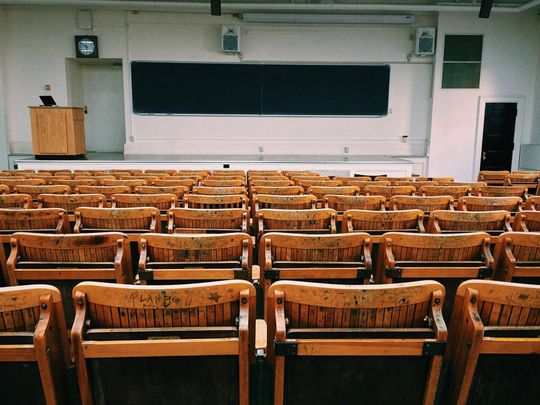
My students shuffled in and sank into their seats, six feet apart, at tables set up in what is usually an event space at the college where I teach, repurposed for the covid era.
“You look exhausted and stricken,” I said, shaking my head. They nodded, and one even put his head down on the table. We were in the last full week of classes. Because of a strict coronavirus testing regimen and the fact that the students had followed the safety protocols, we had been able to have in-person classes all semester. I was grateful. It had worked, to the surprise of most of us, I think. Very few other colleges or universities had tried to be fully face-to-face this fall, and for the first few weeks of the term, most of the schools that tried to failed.
I knew my students were grateful, too. Many of their friends were at home, attending college remotely, and it seemed that they, and the student body in general, understood what a privilege this all was. But that didn’t mean it wasn’t a typically grueling semester, academically. I tried to find a balance between supporting them in these strange circumstances and pushing them as hard as I felt I could, both to distract them and because I always felt like I was racing the clock, racing against a possible virus outbreak that would send us all home again.
I primarily teach first-year writing, and my students are the same age as my eldest child, Maggie, who is doing a gap year at a folk school in northern Norway.
Maggie is learning about the Norwegian concept of “kos” - an idea similar to hygge, finding comfort and coziness in simple surroundings, but with an additional emphasis on finding that with other people, in a social setting. Kos focuses on interpersonal connections (once for safety and survival) through the long winter, and tuning into your own adventurous spirit. Maggie certainly is. Her “line” at the school is focused on dog sledding and wilderness trips, and working and living in close quarters with lots of other people.
In previous years, figuring our way through this new reality would have been a journey I helped guide Maggie on, but now she was off on her own, above the Arctic Circle, making her own way in a world thrown into chaos by a pandemic. I had known that letting her go was going to be hard whenever it happened, but I couldn’t have imagined how helpless I would feel, how all of my protective motherly instincts had to be met with a trust that I had done what I could to equip her to take care of herself.
And week after week, I saw the weariness building in the eyes of the students in front of me, these almost-adults who were babies when Maggie was a baby. I think it was the uncertainty, the disbelief that we were being successful in our efforts, and being haunted always by the possibility that it could all end on a moment’s notice. I considered how their parents, too, had to push away those instincts to protect, and trust that their children, like mine, were equipped to take care of themselves.
Learning under these circumstances is challenging. I was especially concerned about my students who worried about family members at home as case counts rose across the country; they are the children of service workers, teachers, doctors and nurses, people on the front lines. They often said that their families were relieved to have them in a place where they were tested regularly; having them back at home might now feel less safe than having them away at college, yet another bizarre reality of the pandemic.
We were in this adventure together this fall, a journey of hard goodbyes, long separation, and not knowing how or when it’s all going to end. We tried to find that place of knowing we had work to do and being appreciative of the opportunity and space to do it, but never forgetting what was just beyond the bubble we were in: our families, our friends, the whole rest of our lives.
Maggie and I text nearly every day but have only talked, via FaceTime, once or twice; I want to give her all the space she needs. She posts pictures and videos of dog mushing in the mountains of Norway on Twitter, with captions like “this was the best day of my life so far,” and I feel so lucky to be able to enjoy her adventures vicariously. She reminds me that, in different ways, my students are on their own adventures, adventures that I get to be a part of. I want us to enrich our lives as I want Maggie and the people she is with to enrich each other’s.
In this covid era, as we head into winter, I hope we can all find community and adventure in new ways, creating and sharing coziness where we can. With our own children, with the children we educate, with one another.
We don’t know when it’s going to end, but we can support each other along the way.
Elisabeth Fairfield Stokes is an academic
Washington Post





_resources1_16a31069e4e_small.jpg)






